Whether you’re some kind of nutcase for nuts, or more of a casual fan, you’ll have to admit that we’re living in a golden age (of nuts). With so many kinds of nuts available from supermarkets, specialty stores, and online sources, we have access to such a variety of nuts that even the Duke of Nuts himself would be jealous.
Science even tells us that including nuts in your diet can be good for your heart, lower unhealthy cholesterol levels, and reduce the risk of high blood pressure. Nutrition experts recommend that adults eat 4-6 servings of unsalted nuts a week, with each serving equal to 1.5 ounces, a small handful. Since nuts tend to be calorie-dense for their size, it’s important to avoid eating too many.
With so many choices available, we’ve assembled a short list of our favorite kinds of nuts and how to make the most of them. But first, let’s try to crack a very nutty conundrum (aka a conutdrum).
What Makes a Nut A Nut?
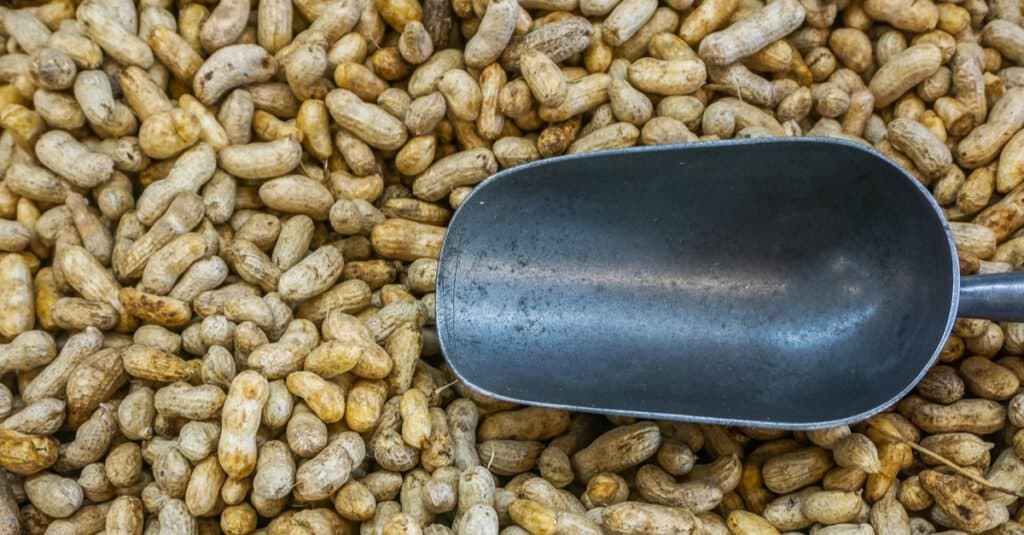
Are these nuts? Yes and no. Mostly no.
©RedDog Photography/Shutterstock.com
Botanically speaking, the term “nut” has a very specific meaning. To botanists, a nut is the dry, hard fruit of a plant, containing a single seed, in a hard outer shell that doesn’t split open. Walnuts and hazelnuts, for instance, match this description. In common language, though, the term has long been applied to almost any crunchy, shelled, seed-like product of a plant. Some examples of misnamed nuts include:
Legumes, like peanuts. These belong to a particular family of plants that produce fruit in a pod.
Drupes. A drupe is a fruit with a fleshy exterior and a pit inside. For some drupes, like cherries or peaches, we eat the exterior and discard the pit. But almonds and cashews are pits that we eat after removing the fleshy husk around them.
Seeds. The Brazil nut is the large, edible seed of a tree found in South American rainforests. Multiple seeds are found inside the tree’s coconut-like pods.
But in the supermarket, as opposed to a horticultural research lab, you’re probably better off using the common, if scientifically inaccurate, meaning of the term “nut.” (Try asking the produce stocker what drupes are on sale and see how far that gets you). So for our purposes, we’ll refer to the foods on this list as “nuts” in the culinary sense.
Read on to learn some new things about the nuts you’re familiar with, and find out about some nuts you have yet to enjoy.
1. Acorns

It turns out that squirreling away acorns isn’t a bad idea.
©iStock.com/suefeldberg
They’re not just for squirrels! These days we may think of acorns as a nuisance that needs to be raked off the lawn, but the fruit of the oak tree has been a traditional food source for communities throughout history, from the ancient Greeks and Assyrians to Native Americans. And rightly so; acorns have half the fat of almonds or peanuts while providing protein, calcium, antioxidants, vitamins A and C, and other nutrients and healthy compounds. The trick with acorns is to remove their tannins, which are bitter chemicals that can be toxic in large amounts. Repeatedly boiling or soaking them, until the water no longer turns brown, accomplishes this. After that, you can roast the acorns to munch on as a snack, or use them in recipes as a substitute for other nuts.
2. Almonds
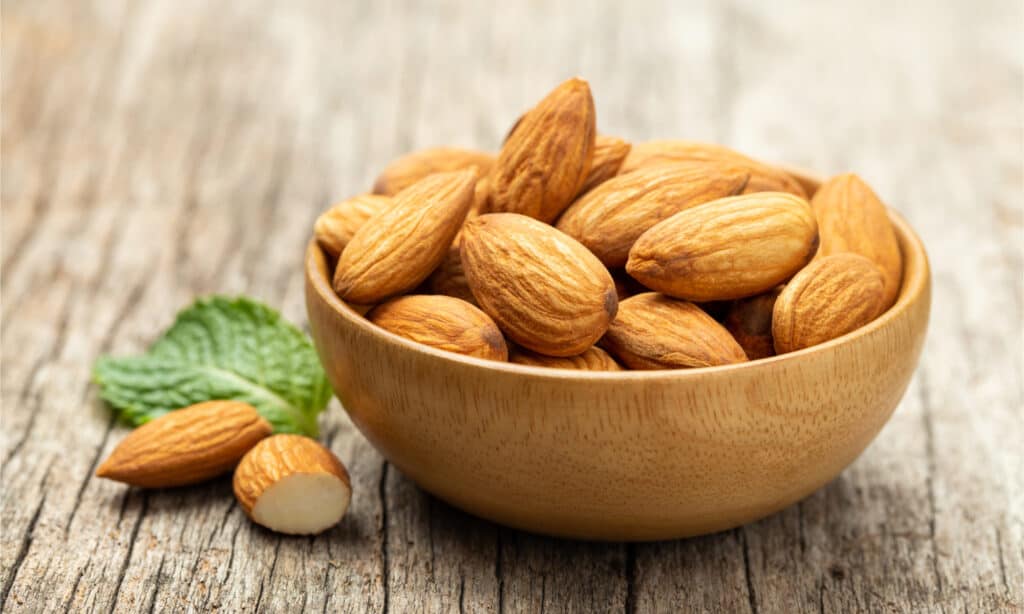
A nut for all seasons: almonds are versatile additions to all sorts of recipes.
©suriya yapin/Shutterstock.com
Most nuts make a good addition to your diet, but almonds seem to have the healthiest rep. They’re high in calcium, vitamin E, fiber, protein, and other nutrients. And it helps that they’re widely available and easy to snack on. Whether you eat them raw or roasted, avoid almonds that have added oil, sugar, flavorings, or other ingredients that add unneeded calories. Almonds are great to add to trail mix or salads, and you can find plenty of recipes that include them.
You’ve probably experienced the unique combo of sweetness and astringency that almonds produce. Research shows that the flavor of almonds is influenced by their texture as well as the aromatic chemical compounds they contain.
3. Brazil Nuts

Brazil nuts grow in coconut-like pods.
©iStock.com/Paralaxis
These large, somewhat moon-shaped nuts are a rich source of selenium, a mineral named for a moon goddess. Coincidence? Yeah, probably. Nevertheless, your body needs selenium for a healthy metabolism and immune system. And a single Brazil nut contains the recommended daily amount for adults. In fact, eating more than a few a day could eventually give you too much selenium. They’re also high in vitamin E and magnesium. The buttery, earthy flavor of Brazil nuts makes them a tasty ingredient in baked goods, as well as burritos, roast chicken, and other savory dishes.
4. Cashews
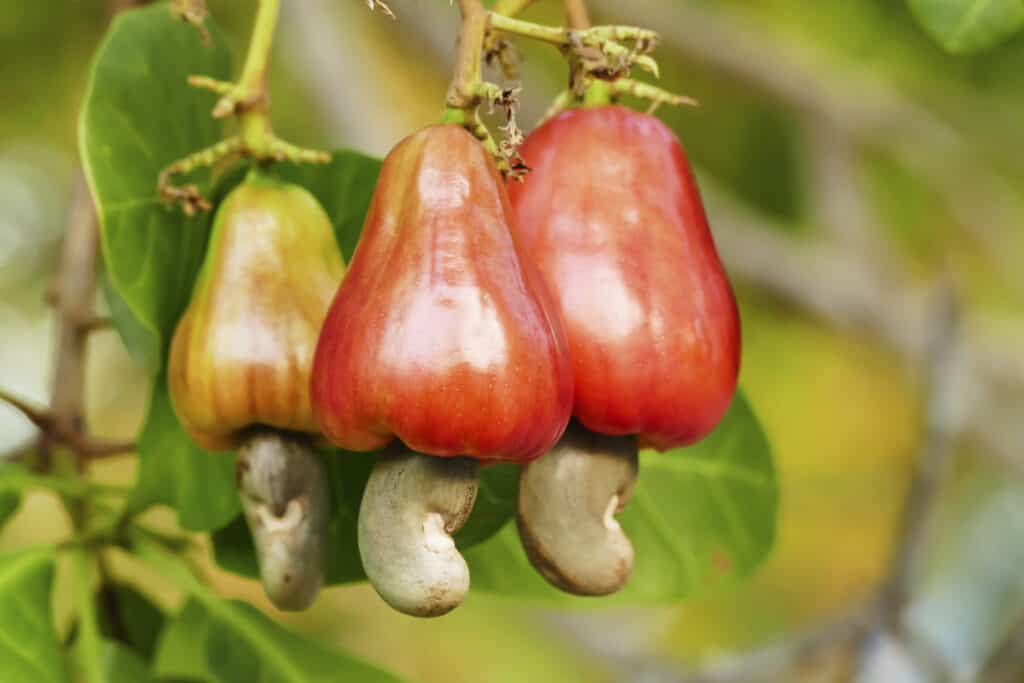
Weird but true: cashews on the tree look like they’re being pooped out of red pears.
©iStock.com/olovedog
Cashew trees are native to Brazil, but were introduced to India in the 16th century, and have since spread throughout southeast Asia. If you’ve never seen a cashew tree, you might be surprised at the strange appearance of this well-known nut. Cashews grow from the bottom of a pear-shaped fruit called a cashew apple. The fruit is edible, but spoils quickly, so it’s usually consumed on or near the growing site. As for the nut, that’s a different story. In the U.S. alone, the cashew market is worth $3.77 million. Your friends in the Global Cashew Council have many suggestions for enjoying the mild, buttery, creamy flavor of cashews.
5. Chestnuts
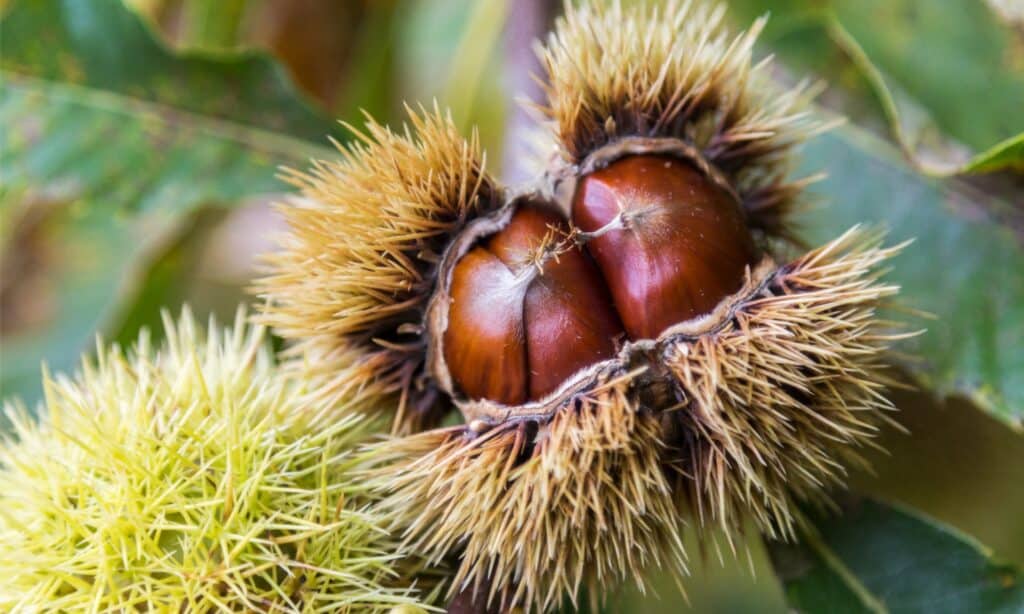
The chestnut’s spiky exterior protects a tasty treasure.
©iStock.com/yuelan
The American chestnut tree was once widespread in eastern North America, and an important source of food as well as timber. But a fungal blight in the early 20th century all but wiped them out, and continues to prevent new growth. Fortunately, nuts from European, Chinese, and Japanese chestnut trees are available, especially during the “chestnuts roasting on an open fire” season. It’s worth enjoying the mild, almost sweet-potato-esque flavor of these nuts all year round, though. Be sure to score the outer skin with a knife before roasting (the oven is fine, no open fire required). In recipes, they’re good additions to stuffing, roast dishes, and soups and stews. Note that the edible chestnut is different from the horse chestnut (inedible!) and the water chestnut (an aquatic vegetable with a chestnut-like appearance).
6. Hazelnuts

Hazelnuts, aka filberts, need to be shelled before eating.
©Svetlana_Smirnova/Shutterstock.com
A marble-sized nut that comes from a tree native to North America, the hazelnut can be eaten raw if you have a nutcracker handy (or buy them shelled). Raw or roasted hazelnuts are sometimes called filberts. Their bold and sweet flavor makes hazelnuts a favored addition to cookies and breads, pasta dishes, salads, and soups. You can even use them in seafood or on pizza. However you eat them, hazelnuts add vitamin E, protein, and fiber to the menu.
7. Macadamia Nuts
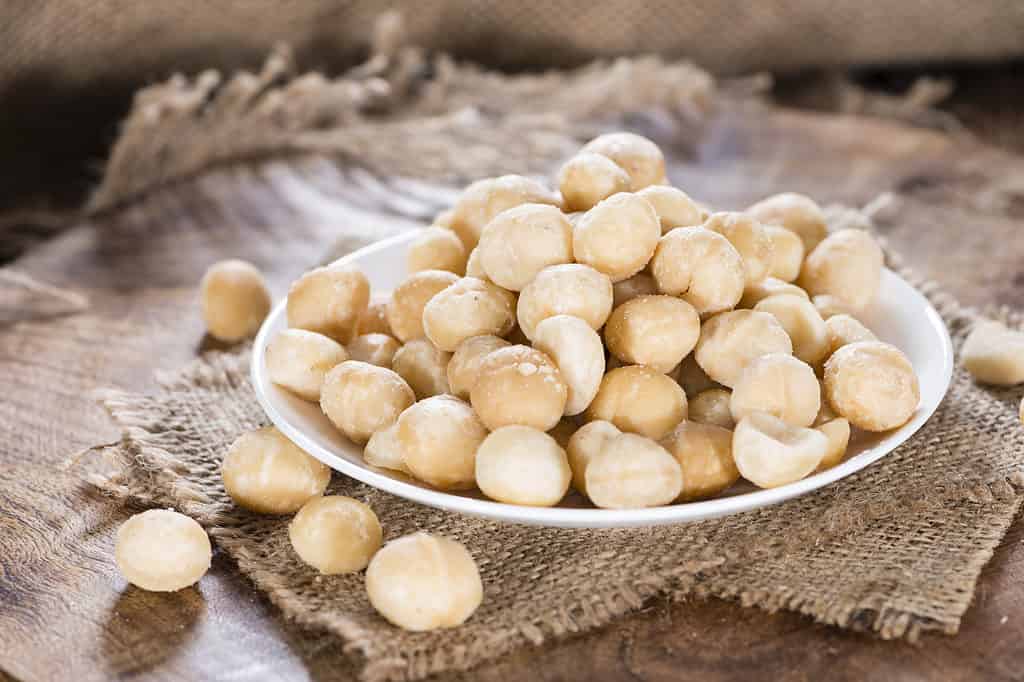
Macadamia nuts are tough to grow and hard to crack.
©HandmadePictures/Shutterstock.com
Though the trees are native to Australia, most macadamia nuts are grown in Hawaii. They’re difficult to grow, as nuts go, so they tend to be more costly. They’re also tough nuts to crack, literally, which is why they’re typically sold with the shells removed. Nevertheless, people love them for their buttery flavor and creamy texture, with a hint of sweetness that’s brought out by roasting. Like other nuts, they offer healthy nutrients. But they are on the calorie-dense side, so be careful to stick to the 1-ounce serving size. Try them out in a mixed greens salad or in a pie crust, or in your favorite cookie recipe.
8. Peanuts

We’ll give you all these peanuts if you promise to stop saying “Actually, the peanut is a legume.”
©iStock.com/White Bear Studio
These familiar goobers are the most consumed nuts in the world. So you’re probably acquainted with the taste, which is kind of like a PB&J sandwich without the bread or jelly. (Fun fact about those sandwiches: 96% of people put the peanut butter on the bread before the jelly.) As mentioned, peanuts are legumes, making them relatives of soybeans, lentils, and peas. But their nutritional content is similar to that of tree nuts, with plenty of fiber, healthy fats, and several vitamins and minerals. That similarity also means that people with an allergy to peanuts should avoid other nuts as well. As many as 40% of people who are allergic to peanuts also react to at least one other type of nut. (Remember, we’re using “nut” in the culinary sense here.)
9. Pecans
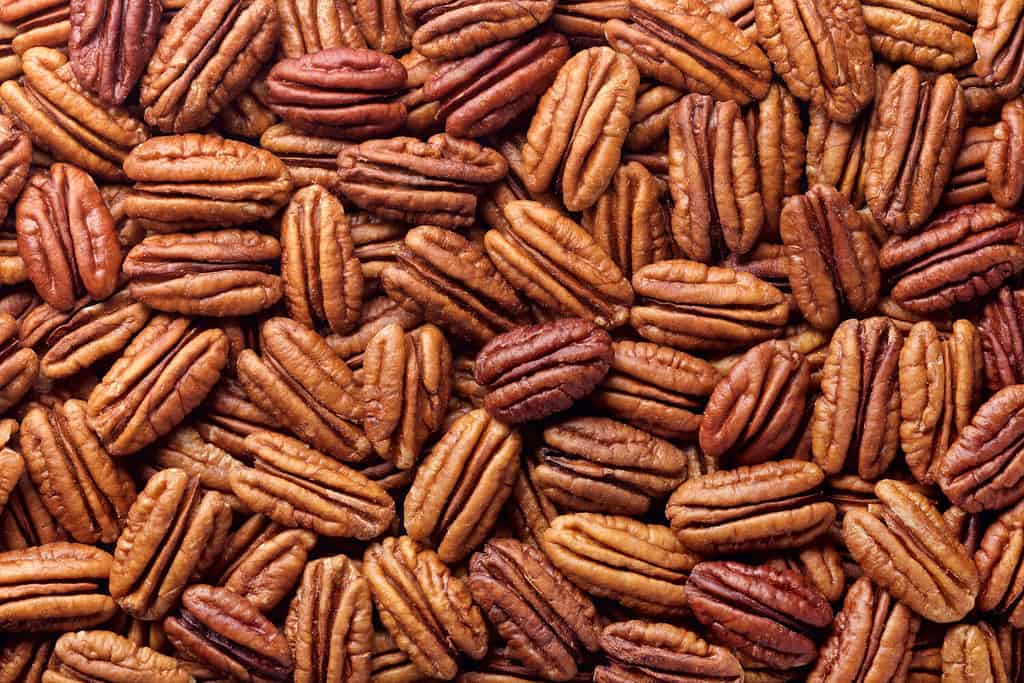
Pie’s not the limit: pecans are delish in all sorts of dishes.
©matin/Shutterstock.com
The sweet, rich, buttery flavor of pecans comes with a substantial dose of protein, fiber, and healthy fats (the kind that are good for your cholesterol levels). Eaten raw or toasted, they’re satisfying enough to take the place of less healthy snacks like potato chips or candy. They do have more calories than other nuts, though, so keep to a serving size of one ounce, which is about 19 pecan halves. Pecan pie is a sure-fire crowd-pleasure, but chopped pecans also make a great coating for fish, a sweet addition to chicken salad, and a flavorful ingredient in pancakes.
10. Pistachios

You’ll never guess what the word “pistachio” means.
©Dumblin Films/Shutterstock.com
Their name comes from a Greek word meaning “the green nut.” And humans have been enjoying these flavorful green nuts for millennia, since 6,000 B.C. at least. Their sweet, piney, tangy flavor of pistachios comes with plenty of nutrients, and fewer calories than some other nuts. If you can keep yourself from eating the whole bag raw, their flavor profile makes pistachios a versatile ingredient on both sweet and savory dishes. You can roast and chop them and add them to everything from ice cream to cake and cookies, to salads, to fish and chicken dishes.
11. Pine Nuts

Pine nuts grow inside pine cones, and they take their time doing it.
©iStock.com/Ana Iacob
If you’ve cooked with these small oblong seeds of the pine tree, you probably know two things about pine nuts. They’re used to make pesto, and they’re surprisingly expensive. To address the second point, the expense has to do with the growing and harvesting process. Pine nuts grow slowly inside of pine cones; in fact, it can take a decade for a pine tree to start producing nuts. And getting them out of the trees is labor-intensive. But many find the cost worth it, for their sweet and, yes, piney taste. If you’re not in the mood for pesto, try sprinkling pine nuts onto yogurt, adding them to your favorite vegetable side dish, or mixing them with rice or other grains.
12. Walnuts
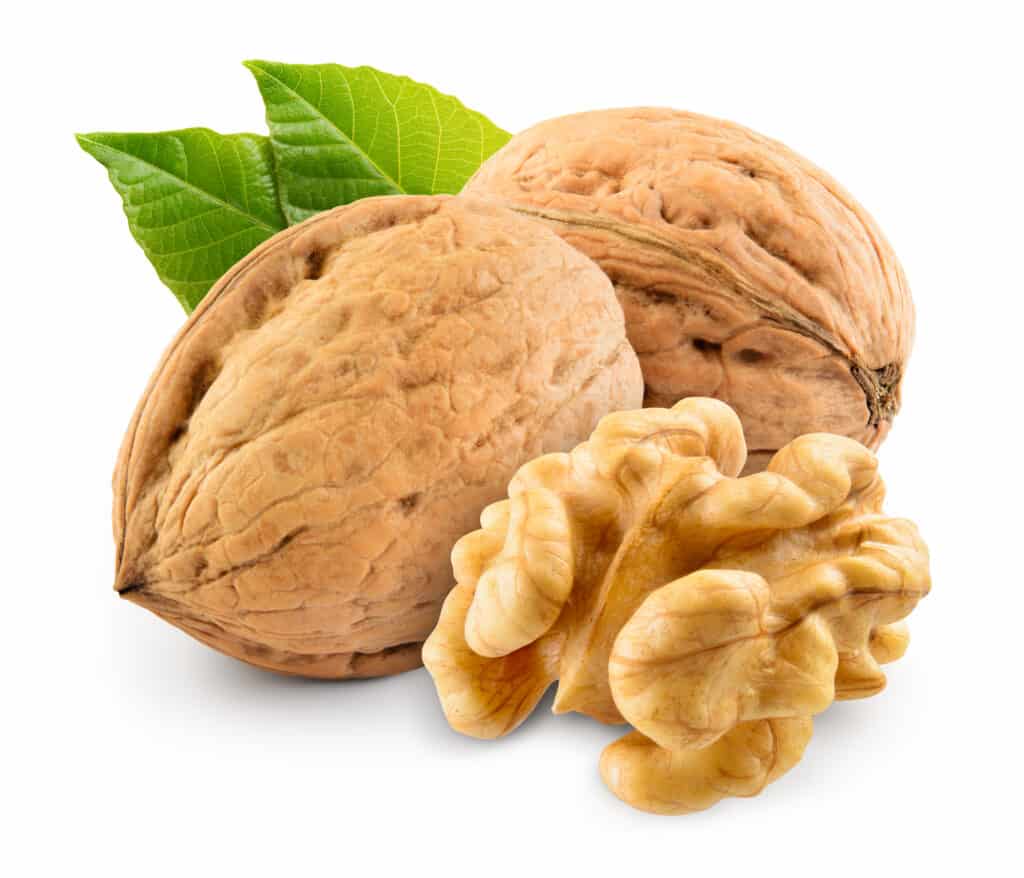
The walnut is an example of a true nut, according to the botanical definition.
©Tim UR/Shutterstock.com
You may not think much about your copper intake, nevertheless, your body does need the mineral for various purposes. And walnuts can provide, with a single serving bringing you half of your day’s daily copper needs. There are about 20 species of walnut trees, some of which produce edible fruit or valuable timber (or both). Perhaps because of their mild flavor, we tend to think of walnuts as ingredients in recipes rather than something to snack on. But the California Walnut Board has a handy booklet that will help you find new ways to enjoy this familiar food. (CWB tip: store walnuts in the fridge or freezer to preserve their flavor.)
The photo featured at the top of this post is © colacat/Shutterstock.com
Thank you for reading! Have some feedback for us? Contact the AZ Animals editorial team.







